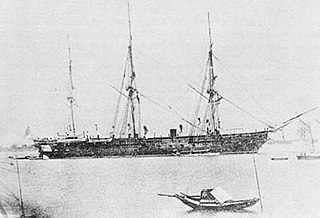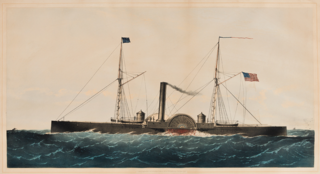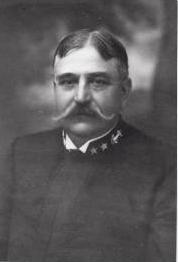
USS Vincennes was a 703-ton Boston-class sloop of war in the United States Navy from 1826 to 1865. During her service, Vincennes patrolled the Pacific, explored the Antarctic, and blockaded the Confederate Gulf coast in the Civil War. Named for the Revolutionary War Battle of Vincennes, she was the first U.S. warship to circumnavigate the globe.

The first USS Colorado, a 3,400-long-ton (3,500 t), three-masted steam screw frigate, was launched on 19 June 1856, by the Norfolk Navy Yard. Named after the Colorado River, she was sponsored by Ms. N. S. Dornin, and commissioned on 13 March 1858, with Captain W. H. Gardner, in command. She was the fifth of the "Franklin-class" frigates, which were all named after US rivers, except for Franklin.
The second USS Guerriere was a frigate in the United States Navy. She was named for the victory of the frigate USS Constitution over HMS Guerriere during the War of 1812.

The first USS Iroquois was a Mohican-class sloop of war in the United States Navy during the American Civil War.

The first USS Ossipee was a wooden, screw sloop-of-war in commission in the United States Navy at various times between 1861 and 1889. She served in the Union Navy during the American Civil War. She was named for the Ossipee River of New Hampshire and Maine. The USS Ossipee was present during the Alaska Purchase.
The first USS Chocura was a Unadilla-class gunboat which saw service with the U.S. Navy during the American Civil War.
The first USS Severn was a wooden screw sloop of war in commission in the United States Navy from 1869 to 1871. She was named for Severn River in Maryland.

USS Vixen (PG-53) was a gunboat of the United States Navy during World War II, in which it served as a flagship to the Commanders of the Atlantic Fleet.

USS Paul Jones was a large 1,210-ton sidewheel, double-ended, steam gunboat of the Union Navy that served during the American Civil War. She carried heavy guns and was assigned to the Union blockade of the waterways of the Confederate States of America.
Edwin T. Woodward, was a naval officer during and after the American Civil War.

USS Osceola was a wooden, sidewheel Sassacus-class gunboat which saw combat with the Union Navy in the American Civil War. She was designed with shallow draft and double-ends specifically to allow her to operate in the narrow rivers and inlets along the Confederate coast. She was well suited to this role and took part in major battles on the James and Cape Fear Rivers.

Estrella was a paddle steamship built by Samuda Brothers in London in 1853 for the Magdalena Steam Navigation Company's commercial services in present-day Colombia. In 1862 she was sold to United States owners and briefly used as a Union Army transport before being acquired by the Union Navy. She served as the armed steamship USS Estrella during the remainder of the American Civil War, carrying three heavy guns as well as two howitzers for shore bombardment.
USS Corwin was a steamer acquired by the Union Navy during the American Civil War. She was used by the Union Navy to patrol navigable waterways of the Confederacy to prevent the South from trading with other countries.
The first USS Peoria was a double-ended sidewheel steamer in the United States Navy.

The Formosa Expedition, or the Taiwan Expedition of 1867, was a punitive expedition launched by the United States against the Paiwan, an indigenous Taiwanese tribe. The expedition was undertaken in retaliation for the Rover incident, in which the Rover, an American bark, was wrecked and its crew massacred by Paiwan warriors in March 1867. A United States Navy and Marine company landed in southern Taiwan and attempted to advance into the Paiwan village. The Paiwan responded with guerrilla warfare, repeatedly ambushing, skirmishing, disengaging and retreating. Eventually, the Marines' commander was killed and they retreated to their ship due to fatigue and heat exhaustion, and the Paiwan dispersed and retreated into the jungle. The action is regarded as an American failure.
Multiple ships of the United States Navy have been named USS Quinnebaug.

Franklin Jeremiah Drake was a Rear Admiral in the United States Navy. He fought in the American Civil War and the United States expedition to Korea.

The third USS Quinnebaug was originally the Old Dominion Steamship Company Jefferson built by the Delaware River Iron Ship Building and Engine Works, Chester, Pennsylvania. She was launched on 14 October 1898 and completed during June, 1899. The ship was acquired for World War I naval service and, as USS Quinnebaug, participated in planting the North Sea Mine Barrage. In March 1919 the ship returned to service as Jefferson with the Old Dominion Line.

Rear Admiral John Porter Merrell was an officer in the United States Navy. He served in the Spanish–American War and as the 11th President of the Naval War College.

William Edgar Le Roy was an officer in the United States Navy who served in the Mexican War, on the African Slave Trade Patrol, and in the American Civil War. He rose to the rank of rear admiral and late in his career was consecutively commander-in-chief of the South Atlantic Squadron, the North Atlantic Squadron, and the European Squadron.












